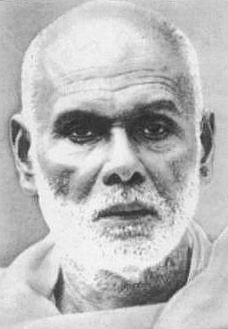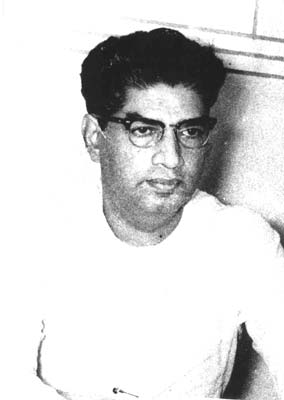
The Kingdom of Travancore, also known as the Kingdom of Thiruvithamkoor or later as Travancore State, was kingdom that lasted from c. 1729 until 1949. It was ruled by the Travancore Royal Family from Padmanabhapuram, and later Thiruvananthapuram. At its zenith, the kingdom covered most of the south of modern-day Kerala and the southernmost part of modern-day Tamil Nadu with the Thachudaya Kaimal's enclave of Irinjalakuda Koodalmanikyam temple in the neighbouring Kingdom of Cochin. However Tangasseri area of Kollam city and Anchuthengu near Attingal in Thiruvananthapuram were parts of British India.

Sree Narayana Guru was a philosopher, spiritual leader and social reformer in India. He led a reform movement against the injustice in the caste-ridden society of Kerala in order to promote spiritual enlightenment and social equality. A quote of his that defined his movement was "one caste, one religion, and one god for all human beings." He is the author of the Advaita poem Daiva Dasakam, which is one of the most used poem in Kerala for community prayer.
Secular National Dravida Party, was a political party in the Indian state of Kerala. The party was founded on 7 January 2004 by elements of the Ezhava caste organization Ezhava Mahajana Sabha. Founding chairman was S. Suvarnakumar. The party professed itself to 'Sreenarayanism', the teachings of Shree Narayana Guru. The party also demanded higher representation for the Ezhava caste in the political process.

Pattom A. Thanu Pillai was an Indian politician and independence activist who served as the 2nd Chief Minister of Kerala from 1960 to 1962. He also served as the Governor of Punjab and Andhra Pradesh.He was considered a central figure in Kerala politics.

Raman Sankar was an Indian politician, statesman, administrator,orator, educationist, writer and editor who served as the 3rd Chief Minister of Kerala from 1962 to 1964.
Kumbalathuparambu Ayyappan, better identified as Sahodaran Ayyappan, was a social reformer, thinker, rationalist, journalist, and politician from Kerala, India. As a vocal follower of Sree Narayana Guru, he was associated with a number of events related to the Kerala reformation movement and was the organizer of Misra Bhojanam in Cherai in 1917. He founded Sahodara Sangam, and the journal Sahodaran and was the founder editor of the magazine Yukthivadi.

Padmanabhan Palpu was a physician from the Kingdom of Travancore who served as a chief medical officer of Mysore State.

The Ezhavas, also known as Thiyya or Tiyyar in the Malabar region, are a community with origins in the region of India presently known as Kerala, where in the 2010s they constituted about 23% of the population and were reported to be the largest Hindu community. The Malabar Ezhava group has claimed a higher rank in the Hindu caste system than the other Ezhava groups but was considered to be of a similar rank by colonial and subsequent administrations.

Mooloor S. Padmanābha Panicker (1869-1931) was a poet and a prominent social reform activist from the Travancore region of present-day Kerala.

T. K. Madhavan Alias Deshabhimani Madhavan, was an Indian social reformer, journalist and revolutionary, who was involved with the Sree Narayana Dharma Paripalana Yogam. He hailed from Kerala and led the struggle against Social discrimination which was known as Vaikom Satyagraha.

The Sree Narayana Dharma Paripalana Yogam (S.N.D.P) is a social service organization that has been representing the Ezhava community from the Indian state of Kerala since 1903.

C. V. Kunhiraman was an Indian social reformer, journalist and the founder of Kerala Kaumudi daily. A follower of Sree Narayana Guru, Kunhiraman was the author of a number of books covering the genres of novels, short story, poetry, biographies and essays. He was one of the leaders involved in the Vaikom Satyagraha of Reformation movement in Kerala which led to the Temple Entry Proclamation.

Thandaaneth Mathai Varghese (1886–1961) was an Indian freedom fighter, lawyer, statesman, former minister and politician from Kerala.
Mannanthala Anandavalleshwaram Devi Temple is a Hindu temple in the Mannanthala suburb of Thiruvananthapuram, India.

Kunhiraman Sukumaran, was the editor of Kerala Kaumudi Daily. He served as the President of Sree Narayana Dharma Paripalana Yogam during 1953-54.

Annie Mascarene was an Indian independence activist, politician and lawyer from Thiruvananthapuram, Kerala. She was a member of the Constituent Assembly of India as representative of State of Travancore-Cochin. In 1952, she became the first woman from Kerala to be elected as a Member of Parliament.

Changanassery Parameswaran Pillai popularly Changanassery, was a social reformer, lawyer, judge, attorney general and the former president of the Nair Service Society. He was elected four times to the Sree Moolam Popular Assembly.

K. T. Achuthan was an Indian politician from Kerala and a leader in the Indian National Congress. He served as Minister for Transport & Labour in both R. Sankar ministry and Pattom Thanu Pillai ministry.

Kumbalathu Sanku Pillai (1898-1969) was a social reformer, politician and freedom fighter from Kollam in erstwhile Travancore. An upper caste by birth, who worked for upliftment of lower Caste, spreading modern education and democratization of Travancore. He was the president of Kerala Pradesh Congress Committee from 1949-1951 and one of the leaders of Vimochana Samaram. He was also the founder and first president of Panmana Ashramam made in commemoration of Chattampi Swamikal.
















